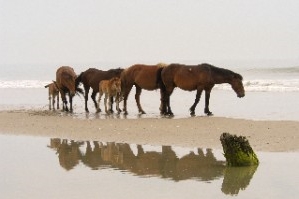Working for Healthy People, Healthy Planet and Sustainable Business
When I was 15 years old and between my sophomore and junior years of high school, I had the tremendous opportunity to study marine biology and oceanography at the college level at Louisiana State University in Baton Rouge. In a 12-week program for high schoolers, I was awarded a scholarship by the National Science Foundation. My parents packed me in a bus at Port Authority in New York, and off I went for the first time away from home. It was then, on a field trip with my fellow program students, that I discovered my commitment to the environment. We were visiting a state fisheries research station on an uninhabited barrier island protecting Louisiana’s marshlands from the Gulf of Mexico. It was a spectacular place. After dinner we were all goofing off and went out for a swim at night in the gulf. It was while we were in the water that a group of a dozen wild horses galloped down the beach, right in front of our eyes on a moonlit night.
This recollection has come back to me very strongly in the wake of the massive oil spill in the Gulf of Mexico that continues to pour out at this moment. The gulf coast is one of the richest nurseries of our major fisheries, and an eco-system beyond compare. It is delicate. And it is being devastated by the spill.
The dead zone in the Gulf of Mexico was already an issue. Threatening to kill the area’s $3 billion fisheries industry, the dead zone is caused by synthetic nitrogen fertilizer runoff from conventional agriculture that travels down the Mississippi River and empties into the gulf. Algae feed on the cheap nitrogen and deplete the waters of oxygen, killing all sea life in the region.
Organic agriculture is a solution to the synthetic nitrogen runoff problem, since these chemicals are prohibited under certified organic standards. Additionally, organic agriculture uses on average 30% less energy inputs and is less reliant on fossil fuels. Additionally, healthy organic soils tie up more carbon, keeping it out of the atmosphere and thus helping to reduce agriculture’s impact on global warming. (Agriculture contributes more than 20% of greenhouse gases toward global warming.)
In today’s news, I read about new research conducted by the University of Montreal and published in the journal Pediatrics. In the study, which followed 1,139 children and interviews with parents, researchers found a strong link between children’s attention deficit disorder (ADHD) and exposure to commonly used pesticides on fruits and vegetables. The researchers found toxic, synthetic organophosphate pesticide residues in the urine of 94% of the kids tested. In 2008, an Emory University study found that when kids switched to organically grown fruits and vegetables in the diet, urine levels of the pesticides dropped to undetectable levels.
There is more substantial data out there that links pesticide use to childhood autism, obesity and early onset diabetes. Endocrine disruptors in pesticides and plastic packaging threaten the metabolism and development of our kids—and also all of us are exposed to the same chemicals. It’s just that the kids soak up more per body weight and are much more impacted by these chemicals in their childhood development.
At Compass Natural, we are working to help communicate the benefits of an economic system that accounts for the significant external costs to our health and environment. If you saw such a system in place, then we would also see the true value of natural, organic and sustainable products and businesses, which help keep these costly toxic chemicals out of our bodies, homes and environment. It would put polluting, toxic industries at a competitive disadvantage.
Speaking of which, I hope BP, Halliburton and the other companies involved in the oil spill, that were pointing fingers of blame at each other in congressional hearings, pay through the nose to account somewhat for this oil spill. I don’t care if they go bankrupt over it; it would be a lesson to others. But no amount of money is going to be able to prevent the impact of the environmental destruction already done. Now there’s an external cost that needs to be accounted for.

